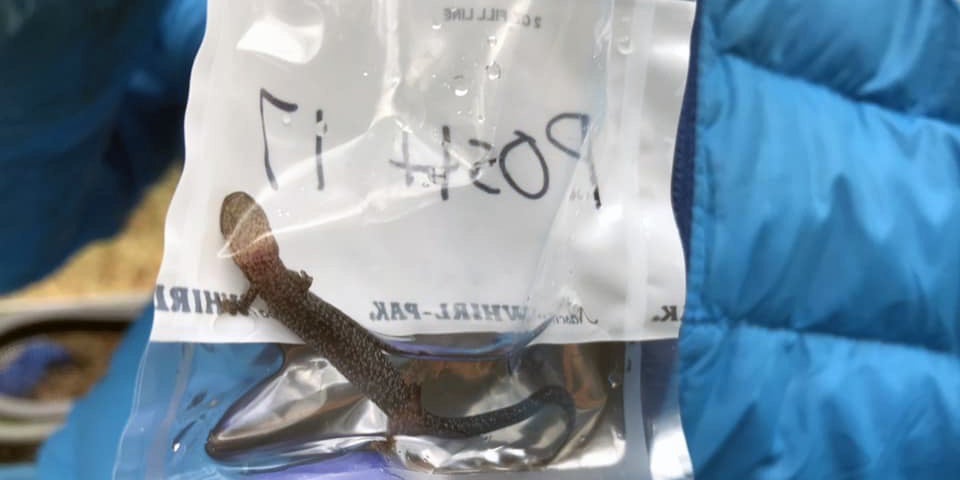Salamanders Helping Salamanders

The secret to salamanders’ survival may be in their slimy secretions. Scientists at the Smithsonian Conservation Biology Institute are swabbing salamanders in Shenandoah, looking for disease-fighting microbes that live in the mucus on their skin. Carly Muletz Wolz, a molecular pathogen scientist and Robert and Arlene Kogod Secretarial Scholar, is working to crack the code on what makes this amphibian goo effective at fighting chytrid fungus.

Why do you find salamanders so fascinating?
Salamanders are slimy, but it is for a very good—and fascinating—reason: their skin needs to be moist in order for them to function. The gooey membrane of mucus that they secrete from their skin enables these amphibians’ basic bodily functions—everything from breathing to making their heart beat.
This mucus is also a great substance for microbes to colonize. Salamander skin is always moist and nutrient rich, making it a more hospitable and stable place to live than water or soil. The mucus can host good microbes as well as bad ones. One of the questions we are trying to answer is what exactly is in their gooey secretions that is so effective at killing two chytrid fungal pathogens: Bd and Bsal.
Some salamanders are very susceptible to chytrid, while others may come into contact with the fungus and have no adverse reaction. We want to know why the survivors are so successful at fighting this disease.

How do you test salamanders for good and bad microbes?
We looked for salamanders on the Smithsonian Conservation Biology Institute’s campus in Front Royal, Virginia. This area has at least nine native species, but we concentrated on four for this study: the red spotted newt, the red-backed salamander, the two-lined salamander and the dusky salamander.
When we catch a salamander, we rinse them off in a bath of clean water to remove any excess dirt or debris. Then, we take a cotton swab and collect a sample of mucus from their skin. Using that swab, we can extract DNA from the sample and test for chytrid and other viral pathogens that could potentially make the animals sick.
We can also look for good microbes and bacteria. Both salamanders and frogs secrete peptides from their skin that have antimicrobial properties, and they have bacteria on their skin that produces metabolites. We use this compilation of molecules in their skin secretions as a proxy to determine how susceptible they are to Bd and Bsal.
Interestingly, when we grow the good microbes and bacteria in the same culture as the bad fungus and pathogens, a microscopic “duel” ensues. Sometimes, the good microbes and bacteria are able to kill these pathogens in culture form. It is a fight to the death—in a petri dish.

What can you learn from microbes?
By pinpointing what makes certain amphibians ‘heartier’ than others, we can help mitigate population declines in salamanders, frogs and other amphibians. Studying animals in our own backyard and under human care can help us predict how susceptible they are to chytrid fungus. We can use that information to better target our conservation strategies and help save specific species.
This can also help Zoo scientists determine which frogs in human care would be the best candidates for reintroduction based on their ability to protect themselves against these pathogens.

Why should we try to save salamanders?
It is easy to overlook salamanders because it is in their nature to stay out of sight. We may catch a glimpse of them, but most of the time they are underground or well camouflaged in their natural environment. However, they are key to our forests’ stability.
In the eastern United States, we have more salamander species than anywhere in the world. About 180 salamander species live in the continental U.S., and about half of those occur within a several hour drive from the Zoo. There are so many salamanders, in fact, that the biomass of just salamanders is greater than that of all the birds and small mammals! Simply because there are so many of them, they are integral to the food web and carbon cycling within forest ecosystems.
Salamanders can benefit humans in other ways, too. They have the most pronounced regenerative properties of any vertebrate and can regrow body parts that were once lost, including tails, limbs, eyes and internal organs. Scientists are studying how salamanders can do this amazing feat. What they learn could have major implications for human medicine in future. Not only that, the peptides in their mucus have the potential to help humans fight disease, too, and could be used in place of antibiotics in certain instances.

What makes you optimistic about salamanders’ future?
Pathogens like chytrid are a major threat to the survival of many salamander species, but our ability to identify the good microbes and peptides that help certain species survive gives me hope for the future of these and other amphibians.
Red-backed salamander populations, which do not appear to be susceptible to either Bd or Bsal, number in the billions. They may be able to provide us insight into their success to help species like the red spotted newt, who is highly susceptible to chytrid. It is an uplifting scenario of salamanders helping salamanders—with a little help from scientists.
This article appears in the December 2018 issue of National Zoo News. Visit the Zoo’s red spotted newts in Amazonia and the red-backed salamanders in the Reptile Discovery Center.
Partners in this study include Brian Gratwicke at the Smithsonian Conservation Biology Institute, Barney Bishop at George Mason University and Doug Woodhams at the University of Massachusetts Boston.


